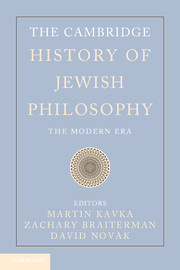Book contents
- Frontmatter
- Contents
- Contributors
- Acknowledgement
- Introduction
- I Judaism's Encounter with Modernity
- II Retrieving Tradition
- 6 Scripture and Text
- 7 Medieval Jewish Philosophers in Modern Jewish Philosophy
- 8 Jewish Enlightenment Beyond Western Europe
- 9 Hasidism, Mitnagdism, and Contemporary American Judaism
- III Modern Jewish Philosophical Theology
- IV Jewish Peoplehood
- V Issues in Modern Jewish Philosophy
- Bibliography
- Index
6 - Scripture and Text
from II - Retrieving Tradition
Published online by Cambridge University Press: 28 September 2012
- Frontmatter
- Contents
- Contributors
- Acknowledgement
- Introduction
- I Judaism's Encounter with Modernity
- II Retrieving Tradition
- 6 Scripture and Text
- 7 Medieval Jewish Philosophers in Modern Jewish Philosophy
- 8 Jewish Enlightenment Beyond Western Europe
- 9 Hasidism, Mitnagdism, and Contemporary American Judaism
- III Modern Jewish Philosophical Theology
- IV Jewish Peoplehood
- V Issues in Modern Jewish Philosophy
- Bibliography
- Index
Summary
The project of “Jewish textual reasoning,” understood to constitute the practice of a subcommunity of contemporary Jewish philosophers, and also “scriptural reasoning,” a related practice engaging Jewish readers with their Abrahamic cousins, is to write from back to front, to begin at the end. This writing with a purpose already in view is not to be “subjective” but to avoid either of two more usual approaches. The more typical academic approach is to trace some practice from historical beginning to end and to seek “objectivity,” which usually means to uncover a narrative that anyone who worked diligently would uncover because it corresponds best to “what is really there.” One “subjective” alternative is to proffer some religious or political ideology and then present a historical sampling of events or texts as proofs that the ideology is true because it – or the corrective need for it – is illustrated by the sampling. This chapter follows a third approach: assuming that the history – in this case, of modern Jewish philosophy – yields several plausible narratives, each of which provides a reasonable account of the overall trajectory of this history. A reasonable narrative can be described in the language of “truth” ('emet) when its author's community of inquiry and practice judges it worthy of “trust” ('emunah), as a narrative that helps deepen or strengthen or repair the community's life in this world.
- Type
- Chapter
- Information
- The Cambridge History of Jewish PhilosophyThe Modern Era, pp. 191 - 223Publisher: Cambridge University PressPrint publication year: 2012



